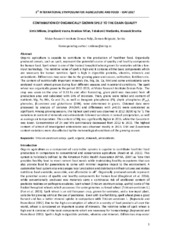Приказ основних података о документу
Contribution of organicaly grown spelt to the quality of grain
| dc.creator | Simić, Milena | |
| dc.creator | Dragičević, Vesna | |
| dc.creator | Brankov, Milan | |
| dc.creator | Tabaković, Marijenka | |
| dc.creator | Kresović, Branka | |
| dc.date.accessioned | 2022-05-16T09:22:23Z | |
| dc.date.available | 2022-05-16T09:22:23Z | |
| dc.date.issued | 2018 | |
| dc.identifier.issn | 2545-4315 | |
| dc.identifier.uri | http://rik.mrizp.rs/handle/123456789/903 | |
| dc.description.abstract | Organic agriculture is capable to contribute to the production of healthier food. Organically produced cereals, such as spelt, represent the potential source of quality and healthy components for human food. Spelt wheat is one of the husked hexaploid wheat grown for centuries within a lowinput technology. The nutritive value of spelt is high and it contains all the basic components which are necessary for human nutrition. Spelt is high in digestible proteins, vitamins, minerals and antioxidants. Differences may occur due to the growing place and season, cultivation, fertilizers etc. The content of nutritionally important minerals (Fe, Mg, Zn, Ca, Mn) and some antioxidants were analyzed in spelt wheat grown during four different seasons and in semiarid conditions. The spelt wheat was organically grown in the period 2012-2015, at Maize Research Institute Zemun Polje. The crop was sown on the area of 0.33 ha and after harvesting, grain yield was measured from all production area and calculated with 14% of moisture. Then, grains were milled and content of nutrients Mg, Fe, Mn, Ca and Zn, as well as inorganic phosphorus (Pi), phytic phosphorus (Pphy), phenolics, β-carotene and glutathione (GSH), were determined in grains. Obtained data were processed by analysis of variance (ANOVA) and differences with p<0.05 were considered as significant. Among growing seasons, the highest spelt yield was observed in 2012 (4200 kg ha-1 ). The variations in content of minerals and antioxidants followed variations in sum of precipitation, as well as average air temperature. The content of Mg was significantly higher in 2015, while the Ca content was lower. Concentration of Zn and Mn continuously decreased from 2012 to 2015. The highest content of almost all investigated antioxidants was observed mostly in 2013. GSH and β-carotene content variations were also affected by the meteorological conditions of the growing season. | sr |
| dc.language.iso | en | sr |
| dc.publisher | Skopje : Faculty of Agricultural Sciences and Food | sr |
| dc.relation | info:eu-repo/grantAgreement/MESTD/Technological Development (TD or TR)/31037/RS// | sr |
| dc.rights | openAccess | sr |
| dc.rights.uri | https://creativecommons.org/licenses/by-sa/4.0/ | |
| dc.source | Journal of Agricultural, Food and Environmental Sciences, JAFES | sr |
| dc.subject | triticum aestivum subsp. spelt | sr |
| dc.subject | organic | sr |
| dc.subject | minerals | sr |
| dc.subject | antioxidants | sr |
| dc.title | Contribution of organicaly grown spelt to the quality of grain | sr |
| dc.type | article | sr |
| dc.rights.license | BY-SA | sr |
| dc.citation.volume | 72 | |
| dc.citation.issue | 1 | |
| dc.citation.spage | 1 | |
| dc.citation.epage | 6 | |
| dc.description.other | Special issue: Book of proceedings, 3rd International symposium for agriculture and food 18-20 October 2017, Ohrid, Republic of Macedonia | sr |
| dc.identifier.fulltext | http://rik.mrizp.rs/bitstream/id/4500/JAFES_72_1_1-6.pdf | |
| dc.identifier.rcub | https://hdl.handle.net/21.15107/rcub_rik_903 | |
| dc.type.version | publishedVersion | sr |


